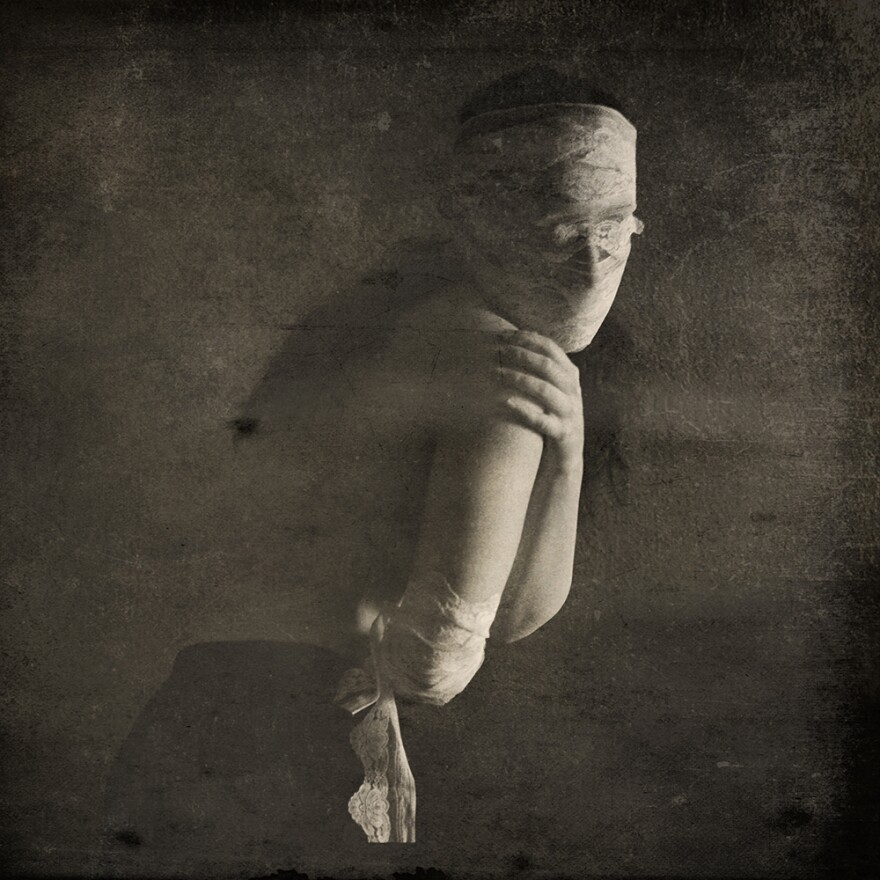Americans with disabilities is a community anyone can join at any time. It’s a community that demands infrastructural and political changes that ultimately benefit everyone, yet it’s a community that is often ignored, sidelined or patronized.
“For years, there were ugly laws that were in place that kept cripples from being out in public. We were locked away in institutions, we were left at home, we were sight unseen. There was a stigma associated with it,” says artist Kathryne Husk.
Among the 14 photographs and two drawings in Husk’s exhibition “Memento Morbus,” at Red Light Gallery in Atchison, Kansas, is a piece called “Weak and Weary.”

The composition is symbolically charged, with shadows of ravens hovering over a hunched, black-clad figure pointing to a feather. The ravens represent the figure’s able-bodied former self; the feather is held up to society as evidence that an able body once existed.
“It’s about feeling like society sees you as old before your time, because your body is unable to do things that you wish it to do,” Husk writes in the accompanying artist’s statement.
Husk, who lives in Olathe, draws imagery from mythology and fairy tales to give able-bodied people a feel for the experience of people with disabilities.
“One of the reasons I pull from (mythology and fairy tales) is that it creates this timeless feel. The disability narrative is timeless,” Husk says.
The Americans with Disabilities Act was not signed into law until 1990, Husk notes. Until then, the disabled community was draped in something like an invisibility cloak.
However, Husk says, “We’ve always been here, we’re not going anywhere, and it’s not just a current issue.”
Husk has multiple disabilities stemming from Ehlers-Danlos Syndrome, a connective tissue disorder that affects mobility and the health of internal organs.
Husk experiences an additional sense of being marginalized because they identify as non-binary transgender. Husk does not dentify as a woman or a man and uses gender-neutral pronouns.

Regardless of where Husk goes, either their gender identity or their disability and use of mobility aids is a sticking point. Many times, queer meeting spaces are physically inaccessible — smaller businesses such as independent coffee shops, for instance.
“If it’s a Christian space, then my body will only be acceptable to a point, depending upon how accessible the space is. But my gender, who I am, will not be accepted. So, you experience different levels of marginalization depending upon the environment, depending upon what you’re interacting with,” they explain.
Husk’s piece “Wrapped” depicts this intersection of queerness and disability.
In the composition, yellow yarn signifies society’s insistence that a queer person or a disabled person present in a “socially acceptable” way. In color symbolism, yellow is for wisdom and the intellect, Husk says; they use it here to convey that society thinks it knows what’s best for individuals.
The individual at the center of the work is backed into a corner, and though they want to break free of the yarn, they must exercise extreme caution in disentangling it; one wrong move can result in further social isolation or a violent death through a hate crime, Husk writes in the piece’s description.
That symoblism is one of the features that attracted Jeff Langlois, Red Light Gallery’s curator and manager, to Husk’s work.
“Every little thing, from the color of the thread in the photo has symbolism. Everything has a meaning behind it,” Langlois says, adding that Husk “really does a lot of research about the ancient meanings of every little thing. They really tell a story, and each photograph stands on its own as a story, which is just fascinating to me.”
Red Light Gallery’s grand opening was October 5. Langlois chose Husk, who is originally from Hawaii and whose work has shown in galleries all across the nation, as the first to be shown in the space.
Langlois says he was also interested in Husk’s work because of their committment to disabled-rights advocacy work.
All of Husk’s work is similarly concept-driven, “conveying emotions through imagery,” as Langlois puts it.
But the pieces address largely practical issues that could be solved through fairly slight alterations in societal attitudes that, Husk says, “continue to push that narrative that we’re less than or to be pitied or that we don’t deserve access.”

Husk points out that many accessibility issues could be remedied by committees and boards of businesses and nonprofits requesting that a person with disablilities be asked to voice their opinion at the outset of planning for an event or new facility.
Husk has volunteered to assist in such meetings in Kansas City, but says no one has ever taken them up on it — even though paying attention to these things benefits the world at large.
“If you’ve ever had to walk with your kid in a stroller you’ve benefited from curb cuts and automatic doors,” Husk says. “Everything that’s been made for the disability community, the world at large benefits from. Yet, we’re the most often forgotten, neglected, just never thought about.”
“Memento Morbus” by Kathryne Husk, 5:30-8:30 p.m. on First Fridays; 5-7 p.m. Wednesdays; noon-7 p.m. Saturdays and by appointment through Friday, January 25 at Red Light Gallery, 715 Commercial Street, Atchison, Kansas 66002.
Follow KCUR contributor Anne Kniggendorf on Twitter, @annekniggendorf.



